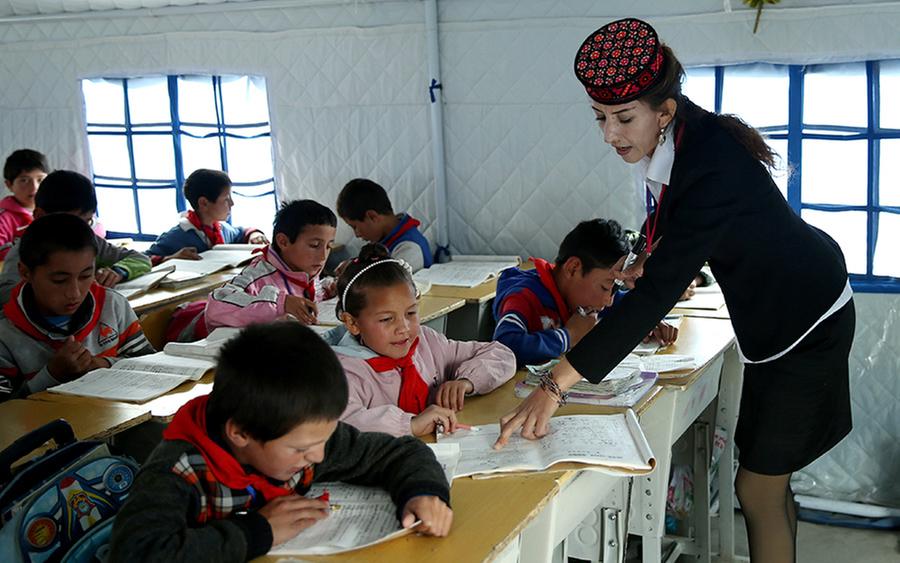Post-quake reconstruction efforts aim to beat winter deadline
By CUI JIA and MAO WEIHUA in Tashkurgan, Kashar prefecture, Xinjiang | China Daily | Updated: 2017-07-14 06:54
 |
Primary school students take a Chinese class in a tent in Tashkurgan Tajik autonomous county, Xinjiang Uygur autonomous region last month. ZOU HONG/CHINA DAILY |
Construction teams rush to finish new, safer dwellings for displaced residents before temperatures plunge
Although it is the middle of summer, Baygenmu Hanjar is already being awakened by the cold at least once a night as the temperature begins to fall on the Pamir Plateau in the Xinjiang Uygur autonomous region.
Baygenmu, 68, has been living in a disaster relief tent since her house in the village of Waerxidie collapsed on May 11 during a magnitude-5.5 earthquake that rocked Tashkurgan Tajik autonomous county in Kashar prefecture, the home of people from the Tajik ethnic group.
The temblor struck at 5:58 am, when most people were asleep. Eight people died and 31 were injured, according to the local government. More than 4,750 houses were destroyed, and about 80 percent of the county's population of more than 33,000 has been affected.
About 800 livestock perished, and the county government estimates that the direct economic loss amounts to 800 million yuan ($118 million). Last year, the county, officially designated as poverty-stricken, generated GDP of just 670 million yuan.
"Winter will come soon on the Pamir Plateau. It has already started snowing in the mountainous areas," Baygenmu said as she leaned on the wooden door frame of her old house in Waerxidie, near Tashkurgan, the county seat. The door frame is the only visible sign of the stone-and-mud house that took the family years to build. Even the low stone wall that is traditional around Tajik dwellings has disappeared.
At a June 6 meeting to discuss reconstruction projects for Tashkurgan, the Xinjiang government pledged to build new, earthquake-resistant houses for all the families that lost their homes, and to ensure that they can move in by the end of August, before the harshest cold starts to arrive.
Sitting at an altitude of 3,090 meters, Tashkurgan, close to China's borders with Pakistan and Afghanistan, is also known as "the town of stones". Large and small stones are scattered across the nearby Gobi Desert and buried in the grassland. The locals have been using the stones, which they believe can actually grow, to build houses for thousands of years.
The county landmark is the remains of a Puli Kingdom fortress, initially built with the stones during the Han Dynasty (206 BC-220). The ruins, which stand on a small hill, escaped damage in the earthquake.
Baygenmu's tent is situated in a temporary settlement for Waerxidie residents, established the day after the quake. Although no one from the village was badly injured, 14 families lost their homes and are now living in the tent village. It's one of 12 such sites across Tashkurgan, all equipped with kitchens and medical centers.
Baygenmu said that it was lucky her family was staying away from home when the quake struck: "Thankfully, I spent the night at a relative's house not far away. The house shook so badly that I was very frightened. However, there wasn't a single crack in the walls because it's one of those earthquake-resistant houses."
























